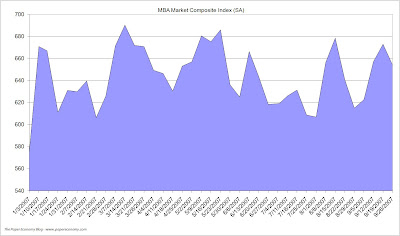
Looking back at Augusts’ results (released throughout September) it now appears that the nation’s housing markets, having been dramatically and irreparably damaged by the mortgage-credit debacle, are now hurling headlong into a dramatic new leg down.
Housing demand’s slowing is accelerating, inventories continue to climb far beyond historic levels, homebuilders have entered “fire sale” mode, Jumbo and No-Doc loans for any borrower have effectively disappeared, and the federal government has just begun to recognize the severity of the issue.
Pending home sales showed a truly stark and horrendous continuation of the historic decline to residential housing on a month-to-month and year-over-year basis, both nationally and in every region.
The Northeast, Midwest, West and the National regions have now fallen WELL BELOW 100 indicating that, seasonally adjusted, home sales activity was below the average activity recorded in 2001, the first year Pending Home Sales were tracked.
The National Association of Realtors (NAR) released their seventh consecutive downward revision to their annual home sales forecast for 2007 putting the current outlook far below the “rose colored” initial predictions from the start of the year.
NAR Chief Economist Lawrence Yun now suggests that residential housing at current prices is a “good long-term investment.”
Countrywide Financial (NYSE:CFC) continues to report tremendous borrower stress with delinquencies jumping 21.69% and foreclosures soaring 150% since August of 2006.
The housing weakness seems to continue to contribute to a pullback in the retail sales of discretionary goods although the near perfect correlation present earlier in the year has begun to decouple. I’ll have a completely new post dedicated to analyzing this correlation in more detail later in October.

 Homebuilder confidence continues to decline to near multi-decade lows with respondents indicating that estimates of “present” and “future” conditions as well as buyer traffic continues to slump.
Homebuilder confidence continues to decline to near multi-decade lows with respondents indicating that estimates of “present” and “future” conditions as well as buyer traffic continues to slump.The Census Department’s New Residential Construction report which continues to indicate troubling weakness in the nation’s housing markets and for residential construction showing substantial declines on a year-over-year basis to single family permits both nationally and across every region.
The July 2007 results of the S&P/Case-Shiller home price indices continued to show weakness for the nation’s housing markets with 15 of the 20 metro areas tracked reporting significant declines.
Topping the list of decliners on a year-over-year basis was Detroit at -9.69%, Tampa at -8.77%, San Diego at -7.78%, Phoenix at -7.30, Washington DC at -7.22%, Miami at -6.14% and Las Vegas at -6.14.


 NAR’s Existing Home Sales Report showing additional confirmation that the nation’s housing markets are now entering a new leg down with EVERY regions showing considerable declines to sales of BOTH single family and condos as well as significant increases to inventory and monthly supply
NAR’s Existing Home Sales Report showing additional confirmation that the nation’s housing markets are now entering a new leg down with EVERY regions showing considerable declines to sales of BOTH single family and condos as well as significant increases to inventory and monthly supplyThe final GDP report for Q2 2007 continued to show a significant drag coming from the decline in residential fixed investment as well as significant revisions to past GDP results better demonstrating the pronounced effects this drag has had for the last four quarters.
The following chart shows real residential and non-residential fixed investment versus overall GDP since Q1 2003 (click for larger version).
 The Census Department’s New Residential Home Sales report for August that again confirmed the hideous falloff in demand for new residential homes as well as reporting a 7.5% decline to the median sales price and significant downward revisions to June and July’s results.
The Census Department’s New Residential Home Sales report for August that again confirmed the hideous falloff in demand for new residential homes as well as reporting a 7.5% decline to the median sales price and significant downward revisions to June and July’s results.As with prior months, on a year-over-year basis sales are still declining significantly dropping a truly ugly 21.2% below the sales activity seen in August 2006.
The Census Department’s Construction Spending report for August again demonstrated the significant extent to which private residential construction spending is contracting.
With the weakening trend continuing, total residential construction spending fell -16.52% as compared to August 2006 while private single family construction spending declined by a grotesque -25.64%.
Key Report Details:
- The seasonally adjusted annul rate of private residential construction spending has now dropped 24.99% from the peak set back in February 2006.
- Overall private residential construction spending dropped -16.52% as compared to August 2006.
- Single Family residential construction spending dropped 25.64% as compared to August 2006.











































